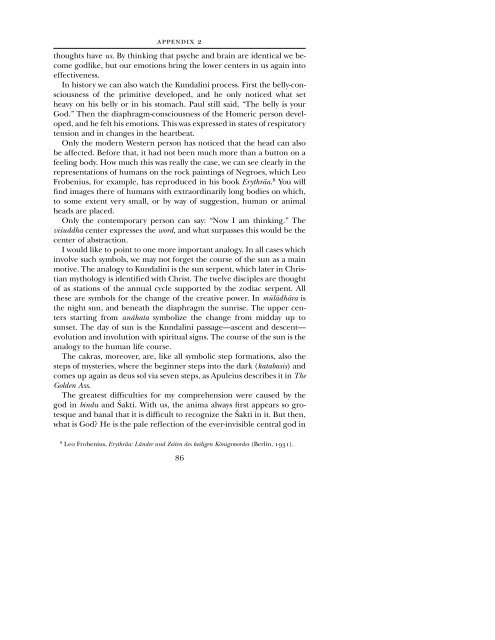CG JUNG - Countryside Anarchist
CG JUNG - Countryside Anarchist
CG JUNG - Countryside Anarchist
You also want an ePaper? Increase the reach of your titles
YUMPU automatically turns print PDFs into web optimized ePapers that Google loves.
APPENDIX 2<br />
thoughts have us. By thinking that psyche and brain are identical we become<br />
godlike, but our emotions bring the lower centers in us again into<br />
effectiveness.<br />
In history we can also watch the Kundalini process. First the belly-consciousness<br />
of the primitive developed, and he only noticed what set<br />
heavy on his belly or in his stomach. Paul still said, “The belly is your<br />
God.” Then the diaphragm-consciousness of the Homeric person developed,<br />
and he felt his emotions. This was expressed in states of respiratory<br />
tension and in changes in the heartbeat.<br />
Only the modern Western person has noticed that the head can also<br />
be affected. Before that, it had not been much more than a button on a<br />
feeling body. How much this was really the case, we can see clearly in the<br />
representations of humans on the rock paintings of Negroes, which Leo<br />
Frobenius, for example, has reproduced in his book Erythräa. 8 You will<br />
find images there of humans with extraordinarily long bodies on which,<br />
to some extent very small, or by way of suggestion, human or animal<br />
heads are placed.<br />
Only the contemporary person can say: “Now I am thinking.” The<br />
viçuddha center expresses the word, and what surpasses this would be the<br />
center of abstraction.<br />
I would like to point to one more important analogy. In all cases which<br />
involve such symbols, we may not forget the course of the sun as a main<br />
motive. The analogy to Kundalini is the sun serpent, which later in Christian<br />
mythology is identified with Christ. The twelve disciples are thought<br />
of as stations of the annual cycle supported by the zodiac serpent. All<br />
these are symbols for the change of the creative power. In mÖlvdhvra is<br />
the night sun, and beneath the diaphragm the sunrise. The upper centers<br />
starting from anvhata symbolize the change from midday up to<br />
sunset. The day of sun is the Kundalini passage—ascent and descent—<br />
evolution and involution with spiritual signs. The course of the sun is the<br />
analogy to the human life course.<br />
The cakras, moreover, are, like all symbolic step formations, also the<br />
steps of mysteries, where the beginner steps into the dark (katabasis) and<br />
comes up again as deus sol via seven steps, as Apuleius describes it in The<br />
Golden Ass.<br />
The greatest difficulties for my comprehension were caused by the<br />
god in bindu and åakti. With us, the anima always first appears so grotesque<br />
and banal that it is difficult to recognize the åakti in it. But then,<br />
what is God? He is the pale reflection of the ever-invisible central god in<br />
8 Leo Frobenius, Erythräa: Länder und Zeiten des heiligen Königsmordes (Berlin, 1931).<br />
86


